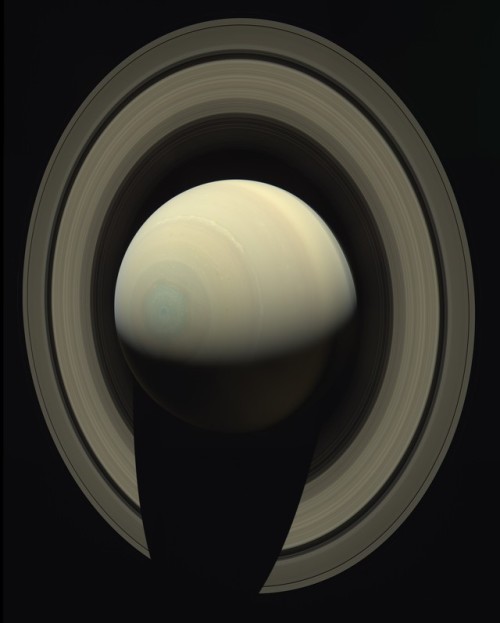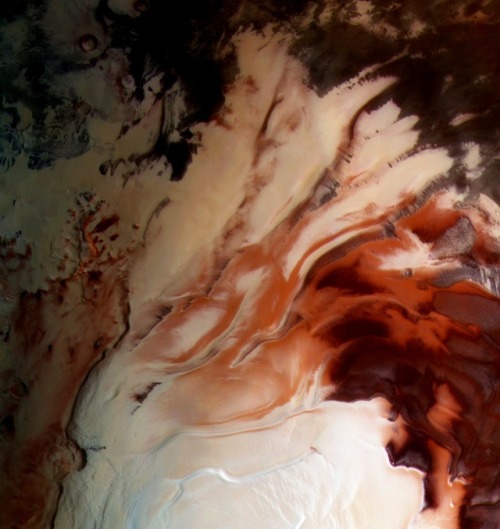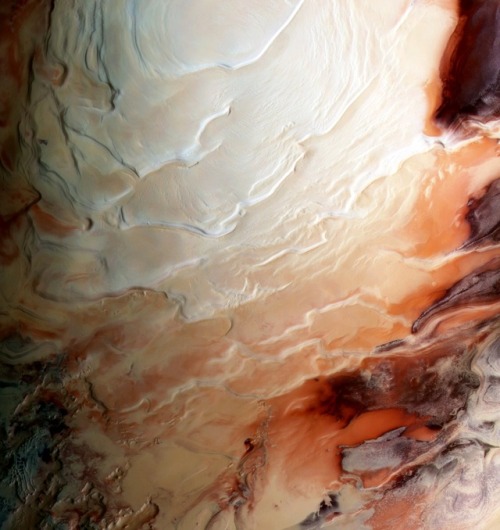Enceladus, Moon Of Saturn, Observed By The Voyager 2 Space Probe On August 26, 1981, From A Distance

Enceladus, moon of Saturn, observed by the Voyager 2 space probe on August 26, 1981, from a distance of approximately 109,000 kilometers.
(Planetary Society)
More Posts from Xyhor-astronomy and Others







10 Spacetime Mysteries That Quantum Gravity Could Solve
“4.) In most approaches to quantum gravity, space-time is not fundamental but made of something else. That might be strings, loops, qbits, or some variant of space-time “atoms” which appear in condensed-matter based approaches. The individual constituents, however, can only be resolved when probed with extremely high energies, far beyond what we can achieve on Earth.”
What is the fundamental nature of the Universe? When it comes to General Relativity, our answer is matter and energy on one hand, and spacetime on the other. But there’s another side to that story: a quantum one. While matter and energy can be discretized into quanta, our notion of spacetime is purely classical. But depending on what our true, fundamental theory of quantum gravity actually is, it could have incredible implications for our Universe. Perhaps we have tiny little black holes popping in and out of existence on a continuous basis; perhaps the vacuum of space isn’t entirely transparent to light; perhaps time turns into space at some level; perhaps wormholes and baby Universes are real. These are mysteries that are currently unresolved, but quantum gravity could provide the answer.
What are the mysteries, and what does it all mean? Sabine Hossenfelder explores, with a fantastic video!

Image of Saturn taken by the Cassini spacecraft in 2013
Image credit: NASA / JPL-Caltech
What’s the deal about gravitational waves?
I guess y’all have heard about the discovery gravitational waves, and the recent observation of gravity waves linked to a visual observation as well.
What are they?
Gravitational waves are disturbances in space-time that are caused by objects in motion. Objects with mass distort spacetime, and thus when they move they also create disturbances. Think moving your hand along the surface of a pond - your hand’s motion creates waves and ripples in the water. Gravity waves were theorized by Einstein when he published his paper on General Relativity in the mid 1900s, and they were finally confirmed by LIGO about a year or two ago. The discovery of gravitational waves was considered the last major test of General Relativity, meaning that everything it’s predicted has held up to testing. As these gravity waves pass through space, they stretch it in one direction and compress it in the other. Check these two gifs out for a good visualization:



What is LIGO?
Ligo, or Laser Inferometer Gravity-wave Observatory, is one of three gravity wave observatories in the world. It works by splitting a laser into two perpendicular components. The light waves travel down long tunnels, bounce off a mirror, and recombine at the intersection. The interference pattern of the two light waves is measured (interference is how two light waves interact with each other - if the peaks and troughs line up, they cancel, but if the peaks line up they add together). When a gravitational wave passes by, it stretches everything in one direction while compressing it in the other direction, then vice versa. This causes a change in the interference pattern, which is then measured. Here’s a good diagram:

If you want more information about gravity waves, check out these videos:
Sources: Image 1 2 3 4, check out the links for good explanations.
Let me know if y’all have any questions!!! I’m happy to answer them.

Saturn photographed by the Cassini spacecraft in 2014
Image credit: NASA/JPL/Cassini; precessed by: Ian Regan
ISS | Credit: NASA
Time-lapse imagery captured June 25, 2017 by Expedition 52.
Solar System: 10 Things to Know This Week
Even the most ambitious plans start with a drawing. Visualizing a distant destination or an ambitious dream is the first step to getting there. For decades, artists working on NASA projects have produced beautiful images that stimulated the imaginations of the people working to make them a reality.

Some of them offered visualizations of spacecraft that had not yet been built; others imagined what it might look like to stand on planets that had not yet been explored. This week, we look at 10 pieces of conceptual art for our missions before they were launched–along with actual photos taken when those missions arrived at their destinations.
1. Apollo at the Moon

In 1968, an artist with our contractor North American Rockwell illustrated a phase of the Apollo lunar missions, showing the Command and Service Modules over the surface of the Moon. In 1971, an astronaut aboard the Lunar Module during Apollo 15 captured a similar scene in person with a camera.
2. Ready for Landing

This artist’s concept depicts an Apollo Lunar Module firing its descent engine above the lunar surface. At right, a photo from Apollo 12 in 1969 showing the Lunar Module Intrepid, taken by Command Module Pilot Richard Gordon.
3. Man and Machine on the Moon

Carlos Lopez, an artist with Hughes Aircraft Company, created a preview of a Surveyor spacecraft landing for our Jet Propulsion Laboratory in the early 1960s. The robotic Surveyor missions soft landed on the Moon, collecting data and images of the surface in order to ensure a safe arrival for Apollo astronauts a few years later. In the image at right, Apollo 12 astronaut Alan Bean examines the Surveyor 3 spacecraft during his second excursion on the Moon in November 1969.
4. O Pioneer!

In missions that lived up to their names, we sent the Pioneer 10 and 11 spacecraft to perform the first up-close exploration of the outer solar system. At left, an artist’s imagining of Pioneer passing Jupiter. At right, Pioneer 11’s real view of the king of planets taken in 1974.
5. The Grand Tour

An even more ambitious pair of robotic deep space adventurers followed the Pioneers. Voyager 1 and 2 both visited Jupiter and Saturn. Voyager 2 went on to Uranus and Neptune. Even the most visionary artists couldn’t imagine the exotic and beautiful vistas that the Voyager spacecraft witnessed. These images were taken between 1979 and 1989.
6. Journey to a Giant

Our Cassini spacecraft carried a passenger to the Saturn system: the European Space Agency’s Huygens probe. Huygens was designed to land on Saturn’s planet-sized moon Titan. At left is an artist’s view of Cassini sending the Huygens probe on its way toward Titan, and at right are some actual images of the giant moon from Cassini’s cameras.
7. Titan Unveiled

On Jan. 14, 2005, the Huygens probe descended through Titan’s thick haze and revealed what Titan’s surface looks like for the first time in history. Before the landing, an artist imagined the landscape (left). During the descent, Huygens’ imagers captured the actual view at four different altitudes (center)—look for the channels formed by rivers of liquid hyrdocarbons. Finally, the probe came to rest on a pebble-strewn plain (right).
8. Hazy Skies over Pluto

David Seal rendered this imaginary view from the surface of Pluto, and in the sky above, an early version of the spacecraft that came to be known as our New Horizons. At the time, Pluto was already suspected of having a thin atmosphere. That turned out be true, as seen in this dramatic backlit view of Pluto’s hazy, mountainous horizon captured by one of New Horizons’ cameras in 2015.
9. Dreams on Mars, Wheels on Mars

Long before it landed in Gale Crater, our Curiosity rover was the subject of several artistic imaginings during the years the mission was in development. Now that Curiosity is actually rolling through the Martian desert, it occasionally stops to take a self-portrait with the camera at the end of its robotic arm, which it uses like a selfie stick.
10. The World, Ceres

No one knew exactly what the dwarf planet Ceres, the largest body in the asteroid belt, looked like until our Dawn mission got there. Dawn saw a heavily cratered world—with a few surprises, such as the famous bright spots in Occator crater.

There’s more to come. Today we have carefully created artist impressions of several unexplored destinations in the solar system, including the asteroids Psyche and Bennu, and an object one billion miles past Pluto that’s now called 2014 MU69.

You can help nickname this object (or objects—there may be two) by submitting your names by Dec. 1. Our New Horizons spacecraft will fly past MU69 on New Year’s Day 2019.
Soon, we’ll once again see how nature compares to our imaginations. It’s almost always stranger and more beautiful than we thought.
Make sure to follow us on Tumblr for your regular dose of space: http://nasa.tumblr.com.


Martian North Pole
ESA / G. Neukum (Freie Universitaet, Berlin) / Bill Dunford

Planet Neptune, observed by the Voyager 2 space probe, August 25, 1989.
(NASA)










December 13, 1965 – Truly spectacular images of our planet captured by the astronauts of Gemini 7 as they zoomed around the Earth. In this era when we receive a daily dose of awesomeness from hi-res cameras on the ISS and various satellites, it’s easy to take beautiful Earth images for granted. I will never cease to be amazed by the stunning photography produced during the Project Gemini missions.
(NASA/Arizona State University)

December 13, 1972 – Photos taken during the Apollo 17 rover’s drive back to the lunar module. (NASA)
-
 greyvvardenfell reblogged this · 1 month ago
greyvvardenfell reblogged this · 1 month ago -
 horseshit-and-gunpowder liked this · 5 years ago
horseshit-and-gunpowder liked this · 5 years ago -
 sphinxnomore liked this · 5 years ago
sphinxnomore liked this · 5 years ago -
 prince-of-places liked this · 5 years ago
prince-of-places liked this · 5 years ago -
 thecozynerd liked this · 5 years ago
thecozynerd liked this · 5 years ago -
 iuliasabina liked this · 5 years ago
iuliasabina liked this · 5 years ago -
 sex-chocolate-and-pain reblogged this · 5 years ago
sex-chocolate-and-pain reblogged this · 5 years ago -
 otlapaliuhcatmetztli liked this · 5 years ago
otlapaliuhcatmetztli liked this · 5 years ago -
 supersaiyanriy reblogged this · 5 years ago
supersaiyanriy reblogged this · 5 years ago -
 gods-favorite-person liked this · 5 years ago
gods-favorite-person liked this · 5 years ago -
 daniel1462 liked this · 5 years ago
daniel1462 liked this · 5 years ago -
 fiona-cummins liked this · 5 years ago
fiona-cummins liked this · 5 years ago -
 generalblazeavenue liked this · 5 years ago
generalblazeavenue liked this · 5 years ago -
 budhunter reblogged this · 5 years ago
budhunter reblogged this · 5 years ago -
 ailatan001 liked this · 5 years ago
ailatan001 liked this · 5 years ago -
 yakutyanochka liked this · 5 years ago
yakutyanochka liked this · 5 years ago -
 dredgen-bazinga liked this · 5 years ago
dredgen-bazinga liked this · 5 years ago -
 joeby942 reblogged this · 5 years ago
joeby942 reblogged this · 5 years ago -
 joeby942 liked this · 5 years ago
joeby942 liked this · 5 years ago -
 magentalace420 reblogged this · 5 years ago
magentalace420 reblogged this · 5 years ago -
 balciicgiyim-blog liked this · 5 years ago
balciicgiyim-blog liked this · 5 years ago -
 reincarnated2a3cycle liked this · 5 years ago
reincarnated2a3cycle liked this · 5 years ago -
 110car8s liked this · 5 years ago
110car8s liked this · 5 years ago -
 mandylee70 liked this · 5 years ago
mandylee70 liked this · 5 years ago -
 shreyagrawal reblogged this · 5 years ago
shreyagrawal reblogged this · 5 years ago -
 nebula52 liked this · 5 years ago
nebula52 liked this · 5 years ago -
 marvelblog123 liked this · 5 years ago
marvelblog123 liked this · 5 years ago -
 littleplasticspaceship reblogged this · 5 years ago
littleplasticspaceship reblogged this · 5 years ago -
 utopic10 liked this · 5 years ago
utopic10 liked this · 5 years ago -
 ermintrud liked this · 5 years ago
ermintrud liked this · 5 years ago -
 squashedfroggy-blog1 liked this · 5 years ago
squashedfroggy-blog1 liked this · 5 years ago -
 persephone228 liked this · 5 years ago
persephone228 liked this · 5 years ago -
 appleciderdoughnut reblogged this · 5 years ago
appleciderdoughnut reblogged this · 5 years ago -
 biyaiya reblogged this · 5 years ago
biyaiya reblogged this · 5 years ago
For more content, Click Here and experience this XYHor in its entirety!Space...the Final Frontier. Let's boldly go where few have gone before with XYHor: Space: Astronomy & Spacefaring: the collection of the latest finds and science behind exploring our solar system, how we'll get there and what we need to be prepared for!
128 posts